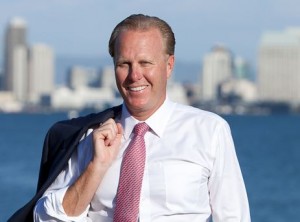
If there is a case against Councilmember Faulconer surviving the primary, it will be made by someone in the “Comments” section. Barring that, the focus of the case against Faulconer is the general election, and it is the downside of Republican unity.
While Republicans surged nationwide in 2010, California was the Democratic firewall. Sen. Barbara Boxer and Gov. Brown won handily and Democratic congressmembers survived. The independent redistricting commission made California one of the few states to add Democratic House members in 2012, including Rep. Scott Peters.
In short, the Tea Party not only never took hold in San Diego, but the litmus test conservatives have shrunk the party. Republicans are a third party in America’s Finest City, outnumbered not only by Democrats but by decline to state (DTS) voters. If all registered voters cast their ballots along party lines, Faulconer wound need more than 70 percent of DTS voters to win.
That may not be out of the question, but it’s akin to drawing an inside straight in poker. The fact is that the hard work of Jess Durfee, labor and others have turned San Diego blue. Not purple. Blue. Those who question this should talk to former Councilmember DeMaio, former Rep. Brian Bilbray and those who ran against Dave Roberts, the first Democratic county supervisor in 18 years.
Yes, off year elections lean toward proven voters, and that leans conservative. Given the numbers, that may not be enough. Given the candidates, it may be irrelevant. Assuming Faulconer makes the general, he will presumably be facing former Assemblymember Nathan Fletcher or Councilmember Alavarez. Both are a problem for Faulconer.
Faulconer vs. Fletcher: If Fletcher makes the general, he will have the Democratic establishment behind him, as well as the independents and moderate Republicans who have stayed with him though his party shifts. That limits Faulconer to the diehard Republicans, whose numbers are no longer enough to win an election.
Faulconer vs. Alvarez. If Alvarez makes the general, Republicans have a shot at the middle. Unfortunately there isn’t enough middle, as the unabashedly progressive Filner proved in 2012. For Fletcher to have any future as a Democrat, he must not only endorse Alvarez, but pull every lever to which he has access in assistance. That, combined with a unified Democratic Party and a surge in Latinos electing one of their own, should be enough to stop Faulconer.
Neither of those scenarios includes the 1 or 2 points to the left that the electorate shifts annually. In short, Faulconer can lock down 45 percent or more, but it’s hard to see how he gets to 51 percent.











